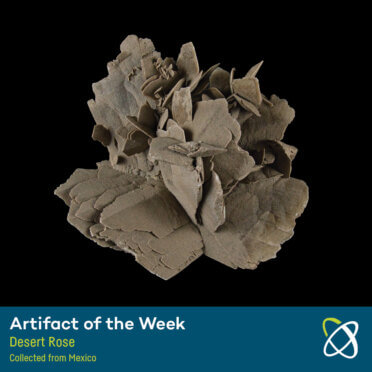Desert Rose – Collected from Mexico
Do you see it? The rose-like formation of this gypsum mineral specimen? This is an example of desert rose, a cluster of gypsum with a unique growth pattern of flattened crystal “petals.” Those petals enclose sand grains as they grow, and fan open in a circular series of flat plates which resemble a rose blossom. This specimen is about ten inches in diameter and weighs nearly eleven pounds!

Gypsum is not the only mineral crystal which can be a desert rose. Barite can also grow into the rose-like formation, but both minerals form the same way. The minerals must have a dry environment with a large source of calcium sulfate and a seasonal fluctuation of water to form, and the crystals grow during the evaporation of water. A shallow salt basin evaporating in the desert would be an example of this; these arid sandy conditions are just right for this growth to take place.
There are some noticeable differences between the two types of desert rose formations that set them apart. Gypsum roses often have sharper crystal edges which are better defined than barite roses. Also, gypsum is usually white, brown, or beige in color while barite tends to be red. Iron oxides present in the sand from the local environment where barite grows give the barite rose its rusty tone.
See more Artifacts of the Week
Artifact of the Month Video Series
Connect with curiosity!










